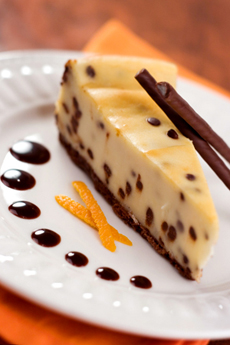 A great way to garnish a piece of cheesecake. Photo by Kelly Cline | IST. A great way to garnish a piece of cheesecake. Photo by Kelly Cline | IST. 
June 2008
Last Updated January 2026
|
 |
All Types Of Cake
Page 2: Charlotte, Chiffon Cake, Cobbler & Other Cake Terms With C
This is Page 2 of an eight-page glossary, cake terms with the letter “C.” Click on the links below to visit other pages. See all of our delicious food glossaries.
Click on a letter to go to the appropriate glossary page.
a b c d e f g h i j k l m n o p q r s t u v w x y z
This glossary is protected by copyright and cannot be reproduced in whole or in part. You are welcome to link to it.
CAKE
|
The meaning of “cake” has changed through the ages. In ancient Roman times, a cake was a small bread; sugar was unknown, and honey was dear. Wealthy Romans did have cheesecakes baked with honey, but they did not resemble today’s rich, creamy cheesecake indulgences. The 19th century was the dawn of the modern cake, thanks to the emergence of the modern oven with a thermostat and universal access to sugar, which had previously been a costly import, affordable only for the wealthy. Today’s cakes are made from a batter or dough of butter (or substitute, such as margarine or oil), eggs, flour, sugar, flavorings, and sometimes a leavening agent such as baking powder or baking soda. Most modern cakes fall into these categories:
|
|
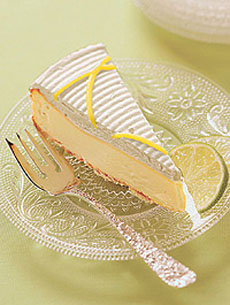
A Key lime cheesecake available from Mackenzie Ltd.
|
- Butter cakes, which often use baking powder to help the cake rise (devil’s food cake and pound cake, e.g.)
- Cheesecakes, which use eggs to help the cake rise, and contain little or no flour, except in the crust (and are actually custard pies, not cakes)
- Foam cakes, airy cakes made with little or no fat (angel food cake, chiffon, meringue, e.g.).
- Fruit cakes, dense, heavy cakes made with candied, dried, and glazed fruits (cherries, citron, citrus peel, currants, dates, pineapple, raisins) and nuts (Dundee cake, election cake, and pecan whiskey cake, e.g.)
- Spice cakes, more casual cakes heavily accented with allspice, cinnamon, and other spices (applesauce cake, jam cake, and gingerbread, e.g.)
- Sponge cakes and angel food cakes, which use beaten eggs to rise (chiffon, génoise, and tres leches cakes, e.g.)
- Yeast cakes, sweeter versions of yeast breads, and the oldest type of cake (babka, savarin, and stollen, e.g.)
Some cakes occupy more than one category; sponge and angel cakes are also foam cakes, and some spice cakes are fruit cakes, for example.
There are 55 cake holidays celebrated each year in the U.S.!
CAKE FLOUR
Cake flour is more bleached and has a higher starch: gluten ratio than all-purpose flour. It is used to produce lighter, less dense, or bright white cakes, such as angel food cake. See flour.
CAKE MIX
Dry baking mixes are a convenience food born of the Industrial Revolution. The first dry mixes, custard powders, were introduced in England in the 1840s. According to FoodTimeline.org, O. Duff and Sons, a molasses company, marketed the first boxed cake mix in the U.S. in the late 1920s or early 1930s. More than half a dozen companies produced cake mixes before World War II; of the enduring brands, it wasn’t until 1947 that General Mills launched Betty Crocker’s first mix.
|
|
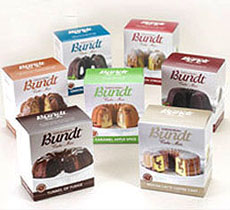
The best cake mixes. Photo courtesy Bundt. |
Early cake mixes were not readily embraced: They produced inconsistent results and, though convenient, were not as good as the “from scratch” cakes homemakers were used to. Even when manufacturers got it right years later, and all one had to do was add water and bake, the complaint was that it “wasn’t like baking.” The solution: have the homemaker add an egg and shortening or oil. Then it was “like home baking,” and today, more cakes are baked from mixes than from scratch. While for most of its history, the cake mix was an inexpensive product, today “gourmet” cake mixes can cost $10.00 a box and more (compared to $2.00-$4.00 for supermarket brands) and are made with finer ingredients. Some bear the names of culinary luminaries such as Jacques Torres and The Barefoot Contessa. The King’s Cupboard cake mix brand and the Bundt cake mix varieties shown above were both NIBBLE Top Picks Of The Week.
CANELÉ or CANNELLE
These bite-sized fluted cakes originated in Bordeaux, in southwestern France, where they can be found on almost every menu. These rich, moist bites, flavored with rum and vanilla, are a perfect ending to dinner with a cup of coffee. They have a soft and tender, custardy center and a dark, thick crust, caramelized to crispness with burnt sugar. The small cylinders are made in striated molds, and there’s a depression at the top.
The pastry is believed to originate at the Couvent (Convent) des Annonciades, in either the 15th or the 18th century. Today, they are widely available in pâtisseries across France and abroad.
|
|
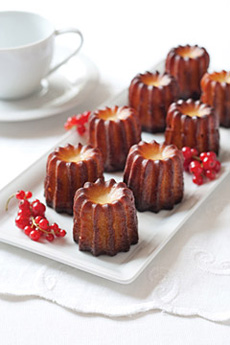
Canelés available from Mackenzie Ltd.
|
CARROT CAKE
According to food historians, modern carrot cake most likely descended from medieval European sweet cakes and carrot puddings. Before the broad affordability of sugar, carrots (and beets) were used to sweeten cakes.
The recipes arrived in America with European immigrants. According to the New York Cookbook by Molly O’Neill (1992), George Washington had a carrot tea cake at Fraunces Tavern in New York City on November 25, 1783. Yet the concept dropped from favor until it was reborn in the 20th century.
The first modern American recipe for what we bake—grated carrots, raisins, cinnamon, and cloves—was a loaf cake first published in 1930 in the Chicago Daily News Cook Book. In the 1960s, hippies embraced it as a “healthy alternative” to traditional desserts. Of course, the only healthy part is the small amount of carrots and walnuts among the butter, flour, sugar, and cream cheese.
Grated carrots mixed into a batter create a lovely, rough-textured spice bread or spice cake with colorful orange flecks; carrots add moisture, too. They are generally combined with walnuts or pecans. (The breads generally have less sugar and are baked in a loaf pan.) Cream cheese frosting is often used to top and fill the cake.
|
|

Get the recipe for this carrot cake (photo © Taste Of Home).

It’s easier to make a carrot loaf cake. Here’s the recipe (photo © Mark Beahan | Simply Recipes). |
National Carrot Cake Day is celebrated on February 3rd.

Our idea of a great piece of carrot cake, at Ocean Prime restaurant in New York City (photo © Ocean Prime).
CASSATA
The traditional version of this Sicilian dessert is made from a light-textured sponge cake stuffed with rum-ricotta filling, laced with candied orange peel. It is often served at Easter. The cake is believed to have originated in Palermo during the 10th century under Arab rule. The name likely derives from the Arabic “quas'at,” meaning bowl and referring to the round pan with sloped sides traditionally used to make it.
The cake began its life quite simply—just sheep’s milk ricotta mixed with honey in the bowl. It evolved over the centuries, and by the Baroque period (circa 1580s-1600), elaborate candied fruit decorations were added. A 1575 document from the Synod of Mazara del Vallo called cassata “indispensable during Easter holidays.”
|
|
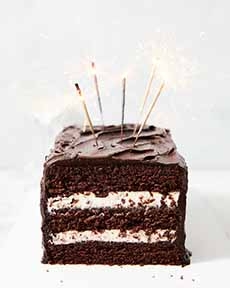
Cassata, here Americanized into a dense chocolate cake, filled with sweetened ricotta cheese and chocolate chips, and iced with fudge frosting. Here’s the recipe (photo © King Arthur Baking). |
In 1873, a Palermo pastry chef, Salvatore Gulì, was the first to formally codify the cassata recipe. The modern cassata features orange-flavored sponge cake layers soaked in liqueur, filled with sweetened ricotta cheese mixed with chocolate chips and candied fruit, wrapped in marzipan (often a vibrant green), topped with white royal icing and ornate candied fruit decorations. It’s rich and visually stunning, whether for Easter or any other celebration.
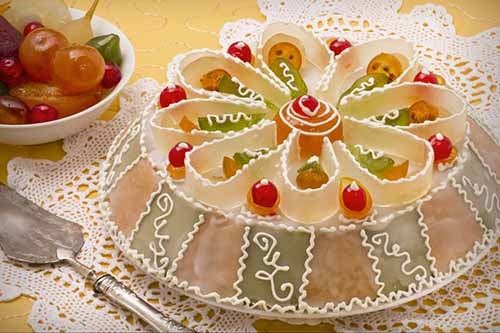
Ready to celebrate? Here’s the recipe for this beauty, a classic Sicilian cassata (photo © Giallo Zefferano).
CHANTILLY CAKE
An airy vanilla (white) layer cake frosted with vanilla whipped cream (Chantilly cream). The cake has been popular for more than a century in the southern U.S. (an 1891 article from Kentucky described something similar. There’s a story that the cake was invented in 1829 at Antoine’s restaurant in New Orleans, but Antoine's didn’t open until 1840.
In 2005, Chaya Conrad, then a baker at Whole Foods in New Orleans, adapted her grandmother’s recipe to create the Berry Chantilly Cake, which went viral, such that the name was copyrighted by Whole Foods.
|
|
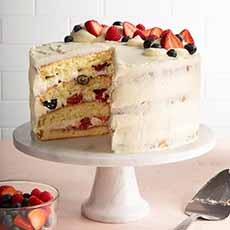
Chantilly cake: pretty for any occasion (both photos © Taste Of Home). |
Chaya layered her cake with fresh berries, with seedless strawberry jam first spread on the layer for an extra burst of flavor. Her version used yellow cake layered with frosting made from cream cheese, mascarpone, heavy cream, and almond extract.
Chantilly is the French name for sweetened whipped cream, which in turn is named after the Château de Chantilly, about 50 kilometers north of Paris.
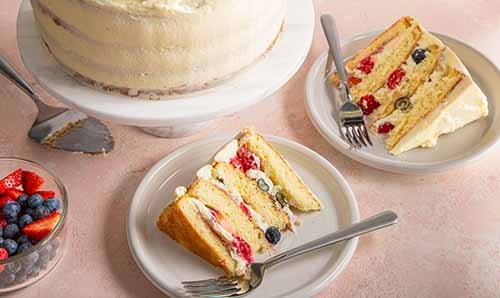
The Berry Chantilly. Here’s the recipe.
CHARLOTTE
A Charlotte is a molded dessert that can be served hot, cold, or frozen; the filling is poured into a mold lined with buttered bread, cake, or ladyfingers, then decorated with fruit, whipped cream, etc. The concept is credited to the great 19th-century chef, Antoine Carême. “Charlotte” is an evolution of the Old English word “charlyt,” meaning a dish of custard. A typical cold Charlotte is made in a ladyfinger-lined mold and filled with Bavarian cream. Frozen charlottes are filled with frozen soufflé or mousse. Charlottes are made with almost every variety of fruit; chocolate and tiramisu charlottes are also popular, as well as holiday flavors like maple and pumpkin.
|
|
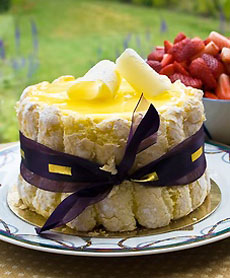
Lemon charlotte. Photo © pr2is | Fotolia. |
- Apple Charlotte is made by lining a mold with buttered bread and filling it with apples.
- Charlotte Malakoff is a mold lined with ladyfingers and filled with a soufflé mixture of cream, butter, sugar, liqueur, chopped almonds, and whipped cream. It is traditionally garnished with strawberries.
- Charlotte Russe, or “Russian” Charlotte, is a cake in which a mold is lined with ladyfingers and filled with custard. It is served cold, with whipped cream.
CHECKERBOARD CAKE
A butter cake that uses a batter ring to create a yellow and chocolate cake (or another contrasting color/flavor cake, such as lavender or strawberry) in concentric layers within each pan. When the baked layers are combined and the cake is sliced, a checkerboard pattern appears. While it looks complicated, all it requires is a special set of pans.
|
|
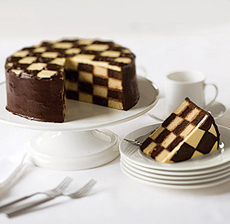
Checkerboard Cake available from Mackenizie Ltd. |
CHEESECAKE
A cheesecake is not a cake, but a custard pie. It is typically made from cream cheese, cottage cheese, Neufchatel, or ricotta, but fresh chèvre and other cheeses have been employed; they can be topped with a layer of sour cream on top. Recipes vary from light and airy to heavy and rich, and there are savory recipes as well as sweet ones. Cheesecakes are baked in a springform pan. They were made prior to classical times and were popular in ancient Greece and Rome. New York cheesecake refers to an all-cream-cheese recipe. There are as many flavors of cheesecake as there are people with the imagination to create them—from key lime to peanut butter to Black Forest—as anyone who has been to a Cheesecake Factory restaurant will attest.
|
|
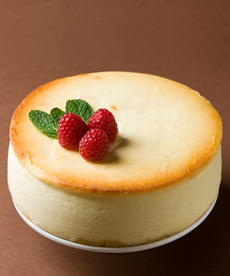
Classic cheesecake available from Zabars.com. |
Cheesecakes are also sculpted into everything from flowerpots to footballs to handbags, as a visit to Elegant Cheesecakes (a NIBBLE Top Pick Of The Week) will also attest.
National Cheesecake Day is celebrated on July 30th.
80 cheesecake recipes, from savory to sweet, appetizer to dessert.
The history of cheesecake.
The year’s 16 cheesecake holidays.

Yes, it’s a cheesecake—topped with chocolate-espresso truffles. Here’s the recipe (photo © DeLallo).
CHIFFON CAKE
According to General Mills, the Chiffon Cake, invented in 1927, was the first new cake to come along in 100 years. (One might dispute that—the brownie debuted within 30 years prior to it, and digging through culinary history will produce more). The secret of this light and fluffy cake is that the egg whites are beaten separately from the yolks, and it uses vegetable oil instead of butter or conventional shortening. It was invented by the aptly named Harry Baker, a Los Angeles insurance agent, who sold the cakes to the Brown Derby restaurant and to Hollywood stars.
In 1947, Baker sold the recipe to General Mills, and it created a sensation when it was published in the May 1948 issue of Better Homes and Gardens magazine. The difference between a chiffon cake and a sponge cake is that a chiffon cake contains oil; most sponge cakes contain no fat. Here’s a recipe for lemon chiffon cake.
Chiffon cake’s closest relative is angel food cake. The main difference is the fat content. Angel food is fat-free, while chiffon contains oil and egg yolks. The result is that angel food is lighter and chewier, while chiffon is moister and richer.
National Chiffon Cake Day is celebrated on March 29th.
|
|
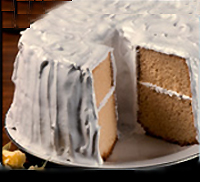
A Burnt Sugar Chiffon Cake (photo © American Egg Board).

Lemon chiffon cake (photo © PPY | Dreamstime).
|

Icing is optional. Here’s the recipe (photo © Taste Of Home).
CHOCOLATE CHAMBORD CAKE
Chocolate and raspberry are a wonderful pairing. Chambord is a brand of raspberry liqueur. This cake infuses a dark chocolate sponge with raspberry liqueur and tops it with bittersweet chocolate ganache icing—an excellent union of both flavors.
|
|
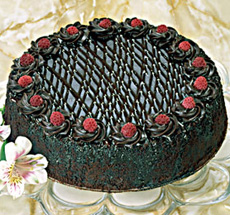
Chocolate Chambord Cake available from 1-800-Bakery.com. |
CHOCOLATE FUDGE CAKE
The difference between a chocolate cake and a chocolate fudge cake is the amount of chocolate in the recipe. A fudge cake will have double the amount of chocolate; for example, four ounces, as opposed to the usual two, in an eight-inch layer cake.
CHOCOLATE SATIN CAKE
A moist, dark chocolate layer cake filled and frosted with chocolate ganache (photo at right). This is a rich and elegant cake. In this version, the sides have been coated with cookie crumbs, and the ganache has been used to create a scroll pattern along the rim.
|
|
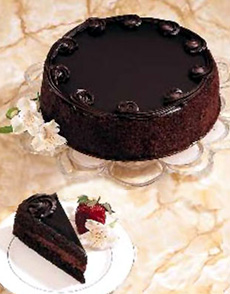
Chocolate Satin Cake is available from 1-800-Bakery.com
|
COBBLER
A cobbler topping is different from a crisp or crumble topping (see below). Although some might see the cobbler as a crustless pie or “spoon pie” (a fruit pie with a filling so juicy it should be eaten with a spoon instead of a fork), it is often classified as a cake. Fruit is baked in a baking dish or casserole, then shortcake batter or biscuit dough is dropped onto the fruit before baking. The dish got its name because the lumps of cooked dough resembled cobblestones. Related desserts include a grunt, which is a spoon pie with biscuit dough on top of stewed fruit (a fruit dish that is steamed, not baked); a pandowdy, a spoon pie with a rolled top crust that is broken up to allow the juices to come through; and a slump, a spoon pie topped with biscuit dough or pie crust, which can be baked or steamed, and can be made upside down.
|
|
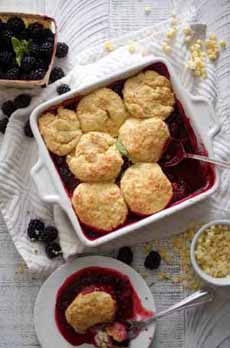
The baked dough topping of a cobbler looks like a cobblestone. Here’s the recipe for this beauty from The Baker Chick. |
COCONUT CAKE
While numerous cake recipes include coconut (German Chocolate Cake, for example), a classic Southern coconut cake is a white or yellow layer cake with a seven-minute frosting (some people use buttercream or marshmallow frosting). The cake is covered in fresh-grated coconut. As with any recipe, there are many variations, including pineapple filling and coconut milk in the batter.
|
|
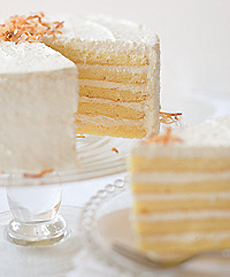
Coconut cake available at Mackenzie Ltd. |
COFFEE CAKE
|
A yeast-leavened cake that is typically served at breakfast, coffee cake is often glazed with white icing or topped with streusel. The latter is also called crumb cake. Coffee cake can contain raisins, nuts, other dried fruits, and chocolate chunks. Most are flavored with cinnamon. More elaborate recipes incorporate cream cheese, jam, and other fillings such as lemon curd. According to FoodTimeline.org, food historians generally agree that the tradition of eating sweet cakes with coffee likely originated in northern or central Europe sometime in the 17th century, when coffee was introduced (see the history of coffee).
|
|
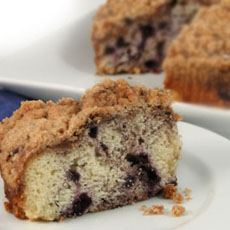
A streusel-topped blueberry coffee cake. Photo courtesy Hancock Gourmet Lobster. |
These areas already had sweet yeast breads, a natural accompaniment that evolved into “coffee cake” made with flour, eggs, sugar, yeast, nuts, dried fruit, and spices. German, Dutch, and Scandinavian immigrants brought the recipes with them to America. Over time, coffee cake recipes evolved to contain sugared fruit, cream cheese, yogurt, and other creamy fillings, streusel, and other toppings.
The line of cinnamon running through the center of a coffee cake is called a cinnamon swirl or cinnamon ribbon. You may also see the terms cinnamon tunnel, cinnamon vein, or simply the “filling layer.” It's created by pouring half the batter into the pan, sprinkling the cinnamon-sugar mixture in a layer, and then covering it with the remaining batter.

Here’s the recipe for this yummy coffee cake (photo © Taste Of Home).
COLOMBA
Colomba, the Italian word for dove, is a dove-shaped sweet yeast cake with a soft and delicate texture, filled with candied orange peel and topped with almonds and sugar grains. Colomba is made with five ingredients: flour, sugar, eggs, butter, and candied orange peel. A unique kneading process and the natural sourdough yeast create a light, fluffy, full-flavored cake. The yeast mixture goes through a three-phase fermentation process before it is blended with the flour and other ingredients, then mixed and left to rise a minimum of three times before baking. It’s a lot of work, but a delicious result.
|
|
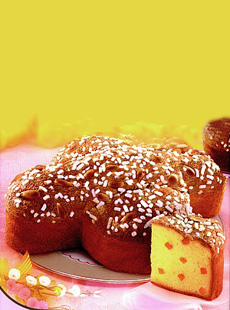
Colomba, shaped like a dove. Photo by Antonio Jiminez Alonson | SXC. |
CONFECTIONERS’ FROSTING
An uncooked buttercream icing made from confectioners’ sugar, unsalted butter, milk, and flavoring.
CONFECTIONERS’ SUGAR or
POWDERED SUGAR or 10x SUGAR
Confectioner’s sugar, also known as icing sugar, is a very finely-ground form of granulated sugar with the consistency of talcum powder. It dissolves quickly to make icing and is used to dust a powdery garnish onto unfrosted cakes. 10x refers to the number of times the sugar is processed to produce a fine powder.
CONGA BAR
A blondie with shredded coconut added to the batter.
|
|
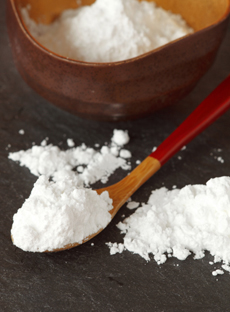
Confectioners’ sugar. Photo by Katharine Pollak | THE NIBBLE. |
CREAM OF TARTAR
Cream of tartar is used in some cake recipes to provide more volume and a finer, whiter crumb. In frostings, it provides extra creaminess. Cream of tartar, or tartaric acid, is a sediment found on the inside of wine casks after fermentation. It is purified and ground to create the baking ingredient.
CRÈME PÂTISSIÈRE
Crème pâtissière, pastry cream, is a stirred custard thickened with cornstarch or flour and typically flavored with vanilla (although other flavors can be used). It is used to fill éclairs or to top fresh fruit tarts and is added to buttercream to make mousseline filling for cake and pastry. It is made of egg yolks, sugar, and cream or milk, like crème anglaise, but the addition of starch gives it the stability to be brought to a boil. With the addition of beaten egg whites, it becomes a crème Saint-Honoré, a filling for cream puffs.
|
|
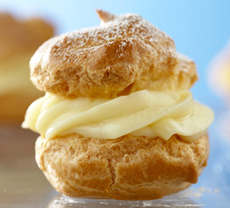
Cream puffs are typically filled with crème pâtissière. Photo courtesy American Egg Board. |
CRÊPE CAKE
See Mille Crêpe Cake.
CRISP or CRUMBLE
A crisp is a deep-dish fruit dessert made with a crumb or streusel topping and baked. The British term is crumble. A cobbler has a pastry top instead of a crumb top (see photo above). Also see betty.
CRUMB CAKE
A coffee cake with a streusel topping.
|
|
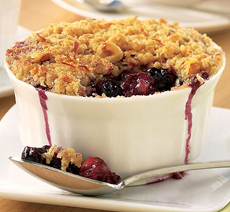
This Wildberry Crisp is available at MackenzieLtd.com.
|
CUPCAKE
Cupcakes are small, individual-portion cakes. They originated in the U.S. in the 19th century. The name is derived from the teacup: Before the advent of muffin tins, cupcakes were often baked in individual teacups (as well as ramekins). Cupcakes became popular because cupcakes baked more quickly and, before the advent of the modern oven in the 20th century, a long-baking item like a cake could burn easily. Muffin tins became popular by the beginning of the 20th century and provided an easier baking receptacle. Paper and foil liners were created for easier removal of the cupcakes from the pan.
|
|

Cupcakes have become works of art. These swans are from Samantha Chiu. Click the link to see more of her beautiful work here (photo © Super Awesome). |
Today’s cupcakes are works of art: They are frosted and often decorated with sprinkles, candies, rosettes, coconut, and other toppings. In recent years, cupcakes have moved beyond children’s party fare and have become popular with pastry chefs and consumers as sophisticated alternatives to large cakes at weddings and other celebrations. Cupcake “trees” stack the cupcakes in the shape of a large, tiered cake.
The history of cupcakes.
National Cupcake Day is celebrated on December 15th, but there are a total of 9 cupcake holidays.

Beautiful flower frosting (photo © Ana Tavares | Unsplash).
Go To Next Page: Terms With D, E & F
Go To Article Index Above
Lifestyle Direct, Inc. All rights reserved. Images are the copyright of their individual owners.

|































